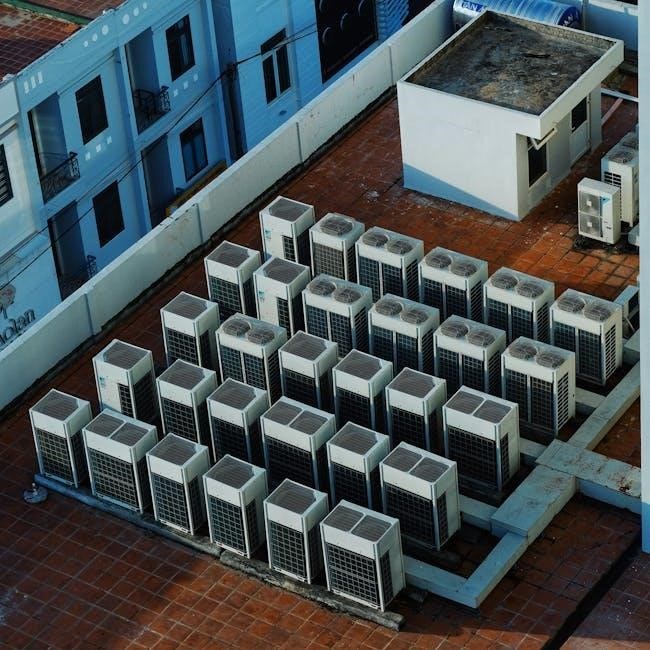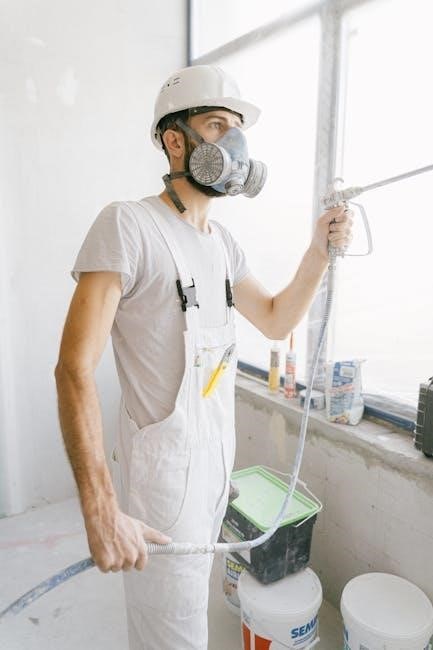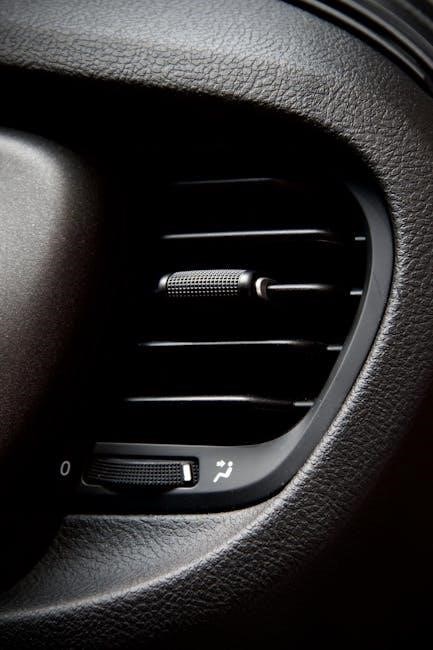
manual air ventilator
Manual air ventilators are essential devices used to assist patients with breathing, delivering air or oxygen into the lungs. They are crucial in healthcare and emergency medicine.
Definition and Purpose
Manual air ventilators are devices designed to assist or replace spontaneous breathing by delivering air or oxygen into a patient’s lungs. They are commonly used in clinical settings, emergencies, or when patients cannot breathe independently. The primary purpose of these ventilators is to provide mechanical ventilation, ensuring adequate oxygenation and carbon dioxide removal. They often involve a resuscitation bag connected to a one-way valve and a face mask, allowing healthcare professionals to manually control breathing patterns. These tools are critical for maintaining respiratory support, particularly in life-threatening situations, making them indispensable in healthcare and emergency medicine.
Historical Context and Development

Manual air ventilators have evolved significantly over centuries, with early versions resembling bellows used to assist breathing. In the 19th century, manual resuscitation devices emerged, laying the groundwork for modern ventilators. The 20th century saw the development of self-inflating bags, revolutionizing emergency medicine. These devices became portable, enabling use in various clinical and prehospital settings. Their design improved with advancements in materials and medical understanding, enhancing patient outcomes. Today, manual ventilators remain essential tools in healthcare, bridging the gap between spontaneous breathing and mechanical ventilation, particularly in emergencies where immediate intervention is critical.

How Manual Air Ventilators Work
Manual air ventilators function by delivering air into the lungs through a tube, using a resuscitation bag squeezed by a professional to push air into the patient.
Mechanical Process of Ventilation
Manual air ventilators operate by using positive pressure to push air into a patient’s lungs through a tube inserted into their airway. This process mimics natural breathing, delivering oxygen-rich air to facilitate gas exchange. The mechanical process involves a resuscitation bag being squeezed by a trained professional, forcing air into the patient’s lungs. This action ensures that oxygen is delivered and carbon dioxide is removed, maintaining proper ventilation. The process is critical in scenarios where patients cannot breathe independently, relying on the manual effort of healthcare providers to sustain respiratory function effectively.
Role of the Resuscitation Bag
The resuscitation bag, a key component of manual air ventilators, delivers air or oxygen into a patient’s lungs. It operates via a self-inflating design or requires manual inflation. When squeezed, it forces air through a one-way valve into the patient’s airway, enabling ventilation. This device is vital in emergencies, allowing healthcare providers to sustain breathing for patients who cannot inhale on their own. The resuscitation bag ensures oxygen delivery and carbon dioxide removal, maintaining adequate gas exchange until mechanical ventilation or natural breathing resumes. Proper technique is essential to avoid lung damage and ensure effective ventilation.

Types of Manual Ventilators
Manual ventilators are categorized into self-inflating bags and free-flow bags. Self-inflating bags automatically refill after compression, while free-flow bags require manual inflation. Both deliver air effectively.
Self-Inflating Bags
Self-inflating bags are a type of manual ventilator that automatically refill with air after each compression. They are designed with internal springs or flexible materials that allow the bag to expand and draw in ambient air once released. This feature makes them highly efficient for continuous ventilation, especially in emergency situations where rapid breath delivery is critical. Self-inflating bags are typically connected to an oxygen source or used with a reservoir to provide enriched air. They are widely used in hospitals and by first responders due to their reliability and ease of operation. Proper training is essential to ensure effective use.
Free-Flow Bags
Free-flow bags are a type of manual ventilator that requires an external air source or oxygen supply to function. Unlike self-inflating bags, they do not automatically refill with air and must be connected to a continuous flow of air or oxygen. These bags are typically used in clinical settings where a steady supply of air or oxygen is available. They are often employed in anesthesia and critical care scenarios, where precise control over ventilation is necessary. Free-flow bags rely on the operator to squeeze the bag and regulate airflow, making them less portable but highly effective in specific situations. Proper technique and connection to an oxygen reservoir are essential for optimal performance.
Comparison of Self-Inflating and Free-Flow Bags
Self-inflating and free-flow bags differ in design and functionality. Self-inflating bags automatically refill with air after compression, making them portable and ideal for emergency situations. Free-flow bags, however, require an external air source and are typically used in clinical settings with oxygen supply. Self-inflating bags are more versatile and easier to use in remote or transport scenarios, while free-flow bags offer precise control in controlled environments. Both are essential tools in manual ventilation, catering to different clinical needs and situations; Proper training is crucial for effective use of either type.

Clinical Applications of Manual Ventilation
Manual ventilation is critical in emergencies, anesthesia, and surgery, providing breathing support when patients cannot breathe independently. It ensures adequate oxygenation and ventilation.
Emergency Situations and First Response
Manual air ventilators are indispensable in emergency situations, providing immediate breathing support to patients who cannot breathe on their own. They are often used in first response scenarios, such as cardiac arrests or respiratory failures, to maintain oxygenation until advanced care is available. Portable and easy to operate, these devices are crucial for paramedics and first responders. During the COVID-19 pandemic, manual ventilators played a vital role in supporting critically ill patients in ICUs when mechanical ventilators were scarce. Their simplicity and effectiveness make them a lifesaving tool in urgent care settings, ensuring patients receive adequate ventilation during critical moments.
Use in Anesthesia and Surgery
Manual air ventilators are widely used in anesthesia and surgical settings to ensure patients receive adequate ventilation during procedures. They are particularly useful when mechanical ventilators are unavailable or as a backup solution. These devices allow anesthesiologists to manually control breathing, ensuring oxygenation and carbon dioxide removal. In surgeries requiring muscle relaxation, manual ventilators help maintain stable respiratory patterns. Their portability and reliability make them indispensable in operating rooms, ensuring patient safety and preventing complications during anesthesia. Trained professionals operate these devices, providing precise ventilation tailored to the patient’s needs, making them a critical tool in surgical care.

Advantages of Manual Ventilators
Manual ventilators are portable, easy to use, and cost-effective, making them ideal for emergency situations and remote settings. They rely on trained professionals for operation.
Portability and Ease of Use
Manual air ventilators are lightweight and portable, enabling healthcare providers to use them in various settings, from hospitals to remote emergency situations. Their simple design ensures ease of operation, requiring minimal training to administer breaths effectively. This portability is crucial in emergencies where quick intervention is necessary. Additionally, their ease of use allows healthcare professionals to focus on other critical tasks while ensuring consistent ventilation support for patients. These features make manual ventilators indispensable in both clinical and prehospital care environments.
Cost-Effectiveness
Manual air ventilators are highly cost-effective, offering an affordable solution for providing ventilation support. Their simplicity in design and functionality reduces production and maintenance costs, making them accessible for healthcare facilities with limited budgets. Unlike mechanical ventilators, manual versions do not require expensive technology or electricity, further lowering expenses. Additionally, their reusability and durability ensure long-term savings. This makes them an indispensable resource in both developed and resource-limited settings, providing critical care at a fraction of the cost of advanced ventilators. Their cost-effectiveness is a key factor in their widespread use across various healthcare environments.

Risks and Complications
Manual air ventilators, while life-saving, pose risks such as lung damage from excessive pressure and complications from improper technique, emphasizing the need for trained professionals.
Potential for Lung Damage
Manual ventilation can cause lung damage if excessive pressure is applied, leading to barotrauma or volutrauma. This risk is heightened in patients with pre-existing lung conditions, as improper technique may rupture alveoli or damage delicate tissues. Trained professionals must carefully monitor pressure levels and adjust ventilation to prevent such complications. Additionally, prolonged use of manual ventilators can irritate airways and potentially cause inflammation or infection if not managed properly. Thus, precision and care are critical to minimize these risks and ensure patient safety during manual ventilation procedures.
Importance of Trained Professionals
Manual air ventilators require skilled operation to ensure patient safety and effectiveness. Trained healthcare professionals understand proper techniques, such as maintaining appropriate pressure and monitoring breathing patterns. Improper use can lead to complications like lung damage or inadequate oxygenation. In critical care settings, their expertise is crucial for adjusting ventilation to meet patient needs. Without proper training, the risk of errors increases, potentially harming the patient. Thus, only qualified individuals should operate manual ventilators to deliver safe and effective breathing support.

Safety Guidelines and Best Practices
Adhering to safety protocols when using manual air ventilators is crucial to prevent complications. Regular maintenance and proper training ensure optimal functionality and patient safety.
Proper Technique and Monitoring
Proper technique is vital when using manual air ventilators to ensure effective ventilation and prevent complications. Trained professionals must monitor breathing rate, airway pressure, and oxygen levels closely. Synchronization with the patient’s natural breathing rhythm is key to avoiding lung damage. Regular assessment of chest rise and breath sounds ensures adequate ventilation. Proper sealing of the mask and one-way valve function must be checked to prevent air leaks. Continuous monitoring helps adjust ventilation parameters as needed, ensuring patient safety and optimal outcomes. Improper technique can lead to serious complications, making skilled operation essential.
Maintenance and Inspection
Regular maintenance and inspection of manual air ventilators are crucial to ensure optimal functionality and patient safety. Inspection should include checking for damage, wear, and proper sealing of valves and connections. Cleaning and disinfecting the device, especially the bag and mask, are essential to prevent contamination. Lubrication of moving parts and replacement of worn components should be done as per the manufacturer’s guidelines. Proper storage in a clean, dry environment is also vital. Regular inspection by healthcare professionals ensures the ventilator is ready for use in emergencies, preventing potential failures and ensuring reliable performance.
Manual air ventilators are vital tools in healthcare, providing critical breathing support. Their simplicity, portability, and effectiveness make them indispensable in emergencies and clinical settings.

Manual air ventilators are portable, cost-effective devices used to assist breathing in emergencies and clinical settings. They rely on positive pressure to deliver air into the lungs, often enriched with oxygen. These ventilators are crucial for patients who cannot breathe independently, providing life-sustaining support. Trained professionals typically operate them, ensuring proper technique to avoid complications. While manual ventilators are indispensable, they require careful monitoring and maintenance to ensure patient safety. Their simplicity and effectiveness make them vital tools in healthcare, particularly in situations where advanced equipment is unavailable.
Future Trends in Manual Ventilation Technology
Future advancements in manual ventilation technology are expected to focus on portability, integration with digital monitoring systems, and enhanced patient safety features. Innovations may include lightweight, compact designs for easier transport in emergency settings. Smart sensors could provide real-time feedback on ventilation parameters, ensuring optimal breathing support. Additionally, eco-friendly materials and energy-efficient designs are likely to emerge, reducing environmental impact. These developments aim to improve efficacy and accessibility, ensuring manual ventilators remain critical tools in both clinical and pre-hospital care environments. Such innovations will enhance the reliability and performance of these life-saving devices.